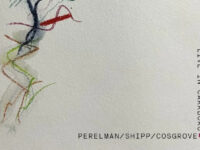When playing extemporaneously, the music that results may not adhere to any particular set rhythm or harmony, so the impressions it leaves behind are the character — colors — of the notes and cadence. Few musicians are as adept at performing this feat as improvisational jazz masters Ivo Perelman and Matthew Shipp. The two continue their fruitful partnership with another set of improvised performances with Complementary Colors (now available through Leo Records), ten tracks titled after colors that hints at the mood of each performance.
The idea of transferring visual concepts into the audial realm is probably more prevalent than we realize; as the liner notes author Neil Tesser points out, we’re “primarily visual creatures,” who describe music with optical metaphors (I know I do). Further, Perelman is a painter in the literal sense who undoubtedly sees his paintings and his music being two parts of the same individual expression.
Perelman and Shipp have been getting together a lot as of late; Colors represent their second duet album this year alone; Callas was the first, is recommended for the same reasons. What reasons, you ask?
First and foremost, the telepathy. They always move in the same direction, and change direction together. The second part is trickier, but the slightest cue signaling an impending turn gets picked up and the appropriate, timely response is made. Check the lithe movement on “Violet” where no energy is wasted and the natural, dancing flow simulates that of a ballet. Or, the ever-shifting modulation on “Green,” a song that endlessly darts from one spot to another.
Another reason is that each performance is its own creature, often evolving into another creature. “Yellow” stands out for its lack of space between notes, but it’s a very liquid progression. “Green and Magenta” expresses a darker mood, in spite of a sometimes bouncy tempo.
A final reason is that both Perelman and Shipp always articulate freely with a connection to tradition. On “Violet And Yellow,” Perelman seems to be playing an abstracted version of an old bop classic, and his vibrato all throughout suggests Lester Young but he fearlessly takes it into unfamiliar settings. Additionally, the saxophonist can project strong emotions such as the long held note during “Blue” that signifies profound sorrow. Or the wistful, sometimes aching delivery performed on “White.”
The musical communion between Ivo Perelman and Matthew Shipp continues to progress into something more and more magical. You have to see hear it to believe it.



